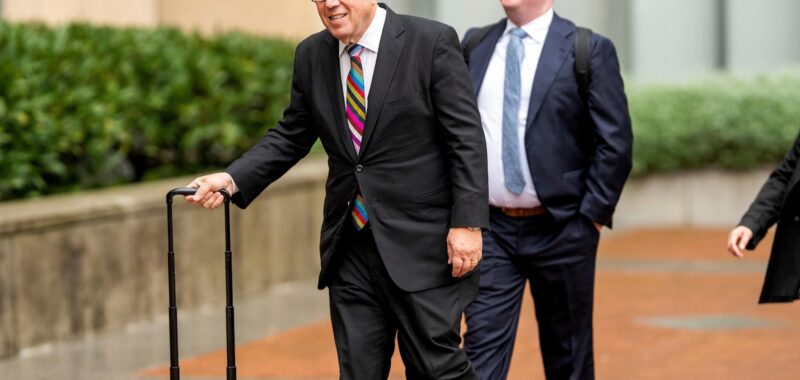The opening of the college football transfer portal has created a dash for cash.
The delay in approving the House vs. NCAA antitrust settlement means the rules around compensation are not yet in place, blowing up the market for the amount of money players can receive from their schools’ name, image and likeness collectives or from third-party endorsement deals.
More than 400 players have entered the portal since it opened Wednesday, according to tracking by 247Sports. Athletes have until April 25 to enter, and they clearly have leverage until the settlement is approved by U.S. District Judge Claudia Wilken in California.
“It’s basically a free pass to pay guys as much as you want to pay them right now,” said Mit Winter, a Missouri sports law attorney who advises agents, collectives and schools. His advice to athletes: “Get your deal signed now before the House settlement gets approved and make sure the payments are made from a collective before July 1.”
Once the House settlement is approved, any NIL deals with a collective or third party over $600 must be reported to a clearinghouse, where it will be vetted to determine if the pay is commensurate with the service provided by the athlete and that it is in line with the athlete’s fair market value. July 1 is the expected date for the settlement to take effect.
Jacob Piasecki and Stefan Aguilera, co-founders of the Austin, Texas-based A&P Sports Agency, have been busy since winter negotiating “frontloaded” NIL contracts that will pay all or most of the money to their clients before July 1.
“It’s like an 11th hour now,” Piasecki said. “We’re getting to the point where collectives are going to be highly scrutinized and everything is going to be under a microscope.”
Michael LeRoy, a University of Illinois labor and sports law professor, said it would have been advantageous for the schools if Wilken had given final approval to the settlement in the days between the April 7 settlement hearing and the opening of the portal this week.
“The lack of closure,” LeRoy said, “adds one more element of chaos.”
The scramble for pay has disrupted college sports the past few seasons, particularly with athletes now free to transfer without having to sit out the following season. This past year alone, quarterback Nico Iamaleava left Tennessee when he was set to reportedly earn $2.2 million next season and QB Matthew Sluka left UNLV, saying the school didn’t come through with $100,000.
In addition to NIL, athletes also will be able to get paid through revenue sharing beginning July 1. Schools are now sending players term sheets or memorandums of understanding regarding pay. Each school will be allowed to distribute $20.5 million to their athletes this year, with football and men’s basketball players likely to receive the lion’s share.
Considering some schools had unofficial NIL payrolls at or near $20 million just for football last year and that there soon will be greater policing of collective and third-party NIL deals, some of the highest-paid players will take pay cuts this year unless their current deals are renegotiated before House approval.
Piasecki and Aguilera predicted a random Power Four quarterback who earned $2 million in 2024 might make only half that in 2025 because of the rev-share and NIL caps.
Winter agreed some players could make less, “but they still will be able to negotiate within whatever budget a school has. There’s still going to be collectives at a lot of schools that will come in to fill gaps or go over that cap as well.”
How would a collective fill a pay gap if any deal over $600 must go through the clearinghouse?
“The way it’s envisioned now, the athletes are responsible for reporting deals with collectives and boosters to the new enforcement entity,” Winter said. “Probably like now, there’ll be lots of deals that don’t get reported.”
Experts say lawsuits are a certainty, noting limits have been placed on rev-share and NIL pay without collective bargaining involving the athletes and their representatives. Because college athletes are not considered employees, collective bargaining is not required. Conferences and schools have lobbied Congress to codify the House settlement and bake in some level of antitrust protection.
As the settlement is written, if the clearinghouse disallows an NIL deal, the athlete is ineligible if they go forward with it. Otherwise, they can renegotiate the deal or go to arbitration and try to show why the deal is within fair market value.
Winter said the formula for determining fair market value is nebulous. He said it’s his understanding the athlete’s performance, social media followers and the market in which their school is located will be factors.
“Who’s to say what’s fair market value if someone wants to pay someone X?” Winter said. “How can you say their fair market value is not X?”
As for enforcement, the power conferences are establishing an enforcement arm to oversee adherence to the salary cap and clearinghouse and levy penalties on violators.
“One element that’s in the background that’s going to keep inserting itself into the foreground is these schools want to create a rules structure for everybody else except themselves,” LeRoy said. “That’s always been the history of NCAA competition. We’ll have a rules committee, we’ll have enforcement. The underlying behavior is we find ways to shortcut the rules, spin the rules, even cheat on the rules.
“I look at this new regime as, ‘We’re setting up rules, everybody knows what the rules are.’ And then everybody is thinking about how can you game it, how can you circumvent it?”
___
Get poll alerts and updates on the AP Top 25 throughout the season. Sign up here. AP college football: https://apnews.com/hub/ap-top-25-college-football-poll and https://apnews.com/hub/college-football

